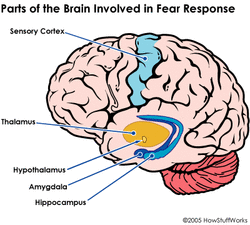what do you fear?
Research: Fear
Science:
Fear is a chain reaction within the brain, starting with a stressful stimulus or outside influence. The end result is a rush of chemicals throughout the body causing your heart to race, respiration to increase, and muscles to go into overdrive. This is commonly associated with adrenaline, and is referred to as the “Flight or Fight response”. The stimulus could be eminent danger or a persistent irrational fear, or phobia. Among other things, the rush of adrenaline causes more blood and oxygen to flow to the muscles, increasing their performance for short bursts of time. This is an evolutionary adaptation for animals, and allows them to cope and survive in possibly dangerous situations. This bodily response is not reserved specifically for possibly deadly incidents. Our brains take in sensory data and analyzes it, and may come up with a false alarm. When we are scared, we instantly feel our life is in danger, but quickly realize we overreacted. The process of fear is mainly autonomic, meaning we do not consciously think about it. Although there are many areas of our brain that are involved in fear, there are a few main components. The amygdala is a cluster of nuclei deep within the temporal lobe and is responsible for our processing our emotions. It is known to handle fear, anger, and pleasure and initiate an autonomic response. The thalmus decides where to send incoming information. This information can be from the ears, mouth, nose, or skin and is interpreted by the sensory cortex.
Fear can go through two paths in the brain. The quickest is the ‘low’ road, and acts before scrutinizing the information. This leads to quick decisions, but they may be uncalled for. This evolutionary adaptation saves animals’ lives everyday and allows species to survive. The areas of the brain that are involved in this reaction are the thalamus, amygdala, and the hypothalamus. The ‘high’ road consists of the thalamus, hippocampus, sensory cortex, amygdala, and finally the hypothalamus. The hypothalamus is responsible for initiating the ‘flight vs. fight’ response. Both roads lead to the hypothalamus, but the second gives more time for the information to be analyzed. The job of the hippocampus is to search the brain for memories of the stimulus. This helps the rest of the chain to precisely decode the information.
Fear can go through two paths in the brain. The quickest is the ‘low’ road, and acts before scrutinizing the information. This leads to quick decisions, but they may be uncalled for. This evolutionary adaptation saves animals’ lives everyday and allows species to survive. The areas of the brain that are involved in this reaction are the thalamus, amygdala, and the hypothalamus. The ‘high’ road consists of the thalamus, hippocampus, sensory cortex, amygdala, and finally the hypothalamus. The hypothalamus is responsible for initiating the ‘flight vs. fight’ response. Both roads lead to the hypothalamus, but the second gives more time for the information to be analyzed. The job of the hippocampus is to search the brain for memories of the stimulus. This helps the rest of the chain to precisely decode the information.
A main
type of fear is instinctive fear. All animals possess it, including humans, and
it is an important evolutionary characteristic. Birds aren’t taught migration
patterns and bears don’t observe and understand hibernation, they just do it.
Predatory animals are feared throughout the animal kingdom, and it doesn’t take
the fittest animal to know to avoid them. The prey of natural predators must
follow their instincts, or they will not survive to adulthood. Fear is an absolutely necessary evolutionary adaptation. Although it can take control of peoples' lives, without it humans would have reached extinction.
Although studies have been done on animals linking the amygdala directly to the fear response, there has been only one study done on a human subject. A woman known as 'SM' feels no fear even under extreme circumstances. She proved to be unfazed by poisonous snakes, horror films, and haunted houses. SM suffers from Urbach-Wiethe disease, a rare recessive disorder. Since its discovery, there has been no more than 300 reported cases. This disorder damaged SM's amygdala when she was young, forever altering the circuits in her brain. Now whenever faced with fear inducing situations, SM reacts with interest and curiosity. Although the amygdala is the most well known brain structure related to fear, it is helped by many other structures. One study cannot prove or disprove anything about regions of the brain, but it clearly points towards the amygdala as an influential player in the process of fear.
Sources:
http://health.howstuffworks.com/mental-health/human-nature/other-emotions/fear.htm
http://news.sciencemag.org/sciencenow/2010/12/fearless-woman-lacks-key-part-of.html?ref=hp&sms_ss=digg&at_xt=4d0b8969eacfaa70%2C0
http://psychclassics.yorku.ca/James/Principles/prin24.htm
(picture) - http://health.howstuffworks.com/mental-health/human-nature/other-emotions/fear.htm
Although studies have been done on animals linking the amygdala directly to the fear response, there has been only one study done on a human subject. A woman known as 'SM' feels no fear even under extreme circumstances. She proved to be unfazed by poisonous snakes, horror films, and haunted houses. SM suffers from Urbach-Wiethe disease, a rare recessive disorder. Since its discovery, there has been no more than 300 reported cases. This disorder damaged SM's amygdala when she was young, forever altering the circuits in her brain. Now whenever faced with fear inducing situations, SM reacts with interest and curiosity. Although the amygdala is the most well known brain structure related to fear, it is helped by many other structures. One study cannot prove or disprove anything about regions of the brain, but it clearly points towards the amygdala as an influential player in the process of fear.
Sources:
http://health.howstuffworks.com/mental-health/human-nature/other-emotions/fear.htm
http://news.sciencemag.org/sciencenow/2010/12/fearless-woman-lacks-key-part-of.html?ref=hp&sms_ss=digg&at_xt=4d0b8969eacfaa70%2C0
http://psychclassics.yorku.ca/James/Principles/prin24.htm
(picture) - http://health.howstuffworks.com/mental-health/human-nature/other-emotions/fear.htm

